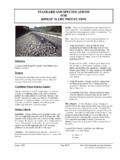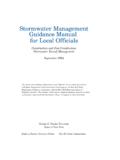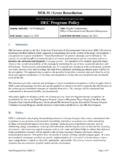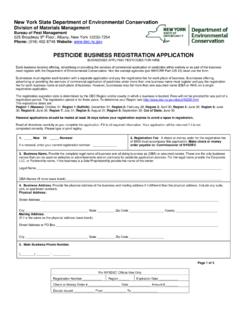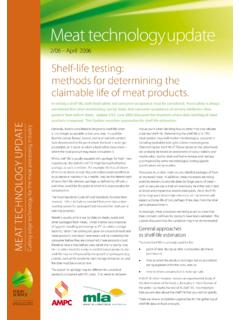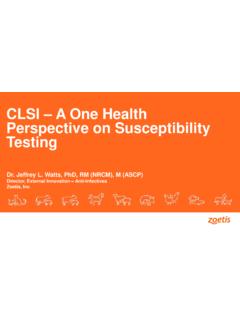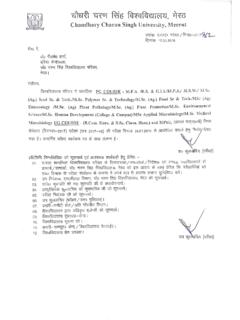Transcription of Activated Sludge Microbiology Problems and Their …
1 1 Presented at the 20th Annual USEPA National Operator Trainers Conference Buffalo, NY, June 8, 2003. Activated Sludge Microbiology Problems AND Their CONTROL Michael Richard, Sear-Brown Fort Collins, CO CONTENTS I. Introduction II. Microbiology Problems and Their Causes 1. Poor Floc Formation, Pin Floc and Dispersed Growth Problems 2.
2 Toxicity 3. Nitrification and Denitrification Problems 4. Nutrient Deficiency and Polysaccharide Bulking and Foaming 5. Zoogloeal Bulking and Foaming 6. Filamentous Bulking 7. Filamentous Foaming III. Practical Control Methods for Filamentous Bulking and Foaming 1. Short Term Control Methods a. Sludge Juggling b. Polymer Addition c. Chlorination 2. Long Term Control Methods a. Low Dissolved Oxygen Problems b. Wastewater Septicity and Organic Acids c. Low F/M Conditions and Selectors d. Nutrient Deficiency e. Foaming Control IV. Summary V.
3 References and Additional Information 2 INTRODUCTION Many Problems can develop in Activated Sludge operation that adversely affect effluent quality with origins in the engineering, hydraulic and microbiological components of the process. The real "heart" of the Activated Sludge system is the development and maintenance of a mixed microbial culture ( Activated Sludge ) that treats wastewater and which can be managed.
4 One definition of a wastewater treatment plant operator is a "bug farmer", one who controls the aeration basin environment to favor good Microbiology . This paper will discuss the types of microbiological Problems that can occur in Activated Sludge operation. These include dispersed (non-settleable) growth, pin floc Problems , zoogloeal bulking and foaming, polysaccharide ("slime") bulking and foaming, nitrification and denitrification Problems , toxicity, and filamentous bulking and foaming. The best approach to troubleshooting the Activated Sludge process is based on microscopic examination and oxygen uptake rate (OUR) testing to determine the basic cause of the problem or upset and whether it is microbiological in nature.
5 These methods are easy, fast and inexpensive compared to other approaches, and are generally understandable and accepted. Microbiology Problems AND Their CAUSES Poor Floc Formation, Pin Floc and Dispersed Growth Problems Basic floc formation, required for Activated Sludge operation due to the use of gravity clarifiers, is due to a growth form of many species of natural bacteria. Floc-forming species share the characteristic of the formation of an extracellular polysaccharide ("slime") layer, also termed a glycocalyx.
6 This material, which consists of polysaccharide, protein and sometimes cellulose fibrils, "cements" the bacteria together to form a floc. Floc formation occurs at lower growth rates and at lower nutrient levels, essentially starvation or stationary growth conditions. Floc-forming species may grow in a dispersed and non-settleable form if the growth rate is too fast. This latter condition, termed dispersed growth, occurs rarely in domestic waste Activated Sludge operation but occurs often in industrial waste treatment, generally due to high organic loading (high food to microorganism ratio (F/M) conditions).
7 Here, no flocs develop and biomass settling does not occur, resulting in a very turbid effluent. The correct remedial action for a dispersed growth problem is a reduction in the F/M of the system, usually done by raising the MLSS concentration. Dispersed growth Problems often occur after a toxicity or hydraulic washout event when the Activated Sludge biomass is low and high F/M conditions prevail. Small, weak flocs can be formed in Activated Sludge that are easily sheared and subject to hydraulic surge flotation in the final clarifier leading to a turbid effluent.
8 These small flocs, termed pin floc, consist only of floc-forming bacteria without a filament backbone and usually 3are <50um in diameter. Pin floc occurs most commonly at starvation conditions -- a very low F/M and long Sludge age. Chronic toxicity can also cause a pin floc condition. Free floating filaments can, at times, cause a dispersed growth problem. Here, the cause is filament-specific and is the same as for filamentous bulking (discussed below). Toxicity Toxic shocks can be a severe problem in Activated Sludge operation.
9 In a recent study, toxicity upset was experienced by approximately 10% of 25 Colorado Activated Sludge plants examined during one year. Toxicity Problems were found to be a larger problem in small communities compared to larger cities, due to the lack of dilution of toxic releases in small systems. Examples of toxicity events were the washing of cement or lime trucks to a manhole, dumping of congealed diesel fuel to the sewer system, and overload of small systems with septage (which contains a high amount of organic acids and sulfides which can be toxic).
10 Sulfide toxicity to Activated Sludge is more common than currently recognized. Sulfide may originate from outside the Activated Sludge system, from septic influent wastewater or from septage disposal, or it may originate "in-house", from anaerobic digester flows or from aeration basins or primary or final clarifiers with Sludge build-up and anaerobic conditions. Hydrogen sulfide toxicity is highly pH dependent, due to the H2S form being the toxic agent and not HS-. The pKa for H2S is , indicating higher toxicity at a pH of 7 or less when H2S is predominant, and less toxicity as the pH increases above pH 7 and H2S dissociates.





